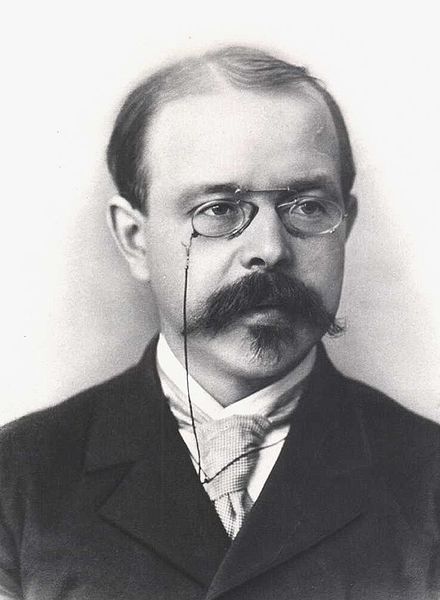<Back to Index>
- Chemist Walther Hermann Nernst, 1864
- Painter Robert Henri, 1865
- Governor General of India Louis Francis Albert Victor Nicholas George Mountbatten, 1900
PAGE SPONSOR

Walther Hermann Nernst (25 June 1864 – 18 November 1941) was a German physical chemist and physicist who is known for his theories behind the calculation of chemical affinity as embodied in the third law of thermodynamics, for which he won the 1920 Nobel Prize in chemistry. Nernst helped establish the modern field of physical chemistry and contributed to electrochemistry, thermodynamics, solid state chemistry and photochemistry. He is also known for developing the Nernst equation.
Nernst was born in Briesen in West Prussia (now Wąbrzeźno, Poland) as son of Gustav Nernst, who was a district judge. Nernst went to elementary school at Graudentz. His mother is said to have been Polish by the Polish news magazine wprost. He studied physics and mathematics at the universities of Zürich, Berlin, Graz and Wuerzburg, where he graduated in 1887.
After some work at Leipzig, he founded the Institute of Physical Chemistry and Electrochemistry at Göttingen.
Nernst invented, in 1897 an electric lamp, using an incandescent ceramic rod. His invention, known as the Nernst lamp, was the successor to the carbon lamp and the precursor to the incandescent lamp. Nernst researched osmotic pressure and electrochemistry. In 1905, he established what he referred to as his "New Heat Theorem", later known as the Third law of thermodynamics (which describes the behavior of matter as temperatures approach absolute zero). This is the work for which he is best remembered, as it provided a means of determining free energies (and therefore equilibrium points) of chemical reactions from heat measurements. Theodore Richards claimed Nernst had stolen the idea from him, but Nernst is almost universally credited with the discovery.
In 1911, with Max Planck, he is the main organizer of the first Solvay Conference in Brussels.
In 1920, he received the Nobel Prize in chemistry in recognition of his work in thermochemistry. In 1924, he became director of the Institute of Physical Chemistry at Berlin, a position from which he retired in 1933. Nernst went on to work in electroacoustics and astrophysics.
Nernst developed an electric piano, the "Neo - Bechstein - Flügel" in 1930 in association with the Bechstein and Siemens companies, replacing the sounding board with radio amplifiers. The piano used electromagnetic pickups to produce electronically modified and amplified sound in the same way as an electric guitar.
His device, a solid body radiator with a filament of rare earth oxides, that would later be known as the Nernst glower, is important in the field of infrared spectroscopy. Continuous ohmic heating of the filament results in conduction. The glower operates best in wavelengths from two to 14 micrometers.
Nernst married in 1892 to Emma Lohmeyer with whom he had two sons and three daughters. He was a vocal critic of Adolf Hitler and Nazism, and two daughters married Jewish men. In 1933, the rise of Nazism led to the end of Nernst's career as a scientist. Nernst died in 1941 and is buried near Max Planck in Göttingen, Germany.